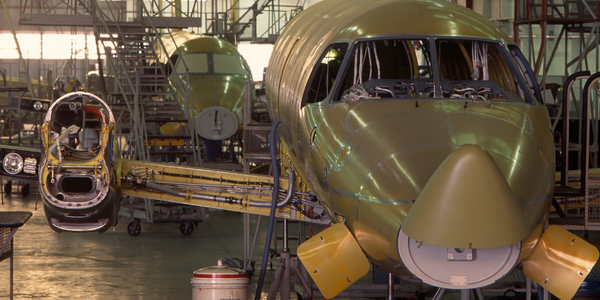下载PDF
Dubai Aerospace Enterprise Enhances Efficiency with GE Digital’s Asset Transfer System

技术
- 功能应用 - 计算机化维护管理系统 (CMMS)
- 功能应用 - 企业资产管理系统 (EAM)
适用行业
- 航天
- 建筑与基础设施
适用功能
- 维护
- 质量保证
用例
- 资产健康管理 (AHM)
- 资产生命周期管理
服务
- 系统集成
- 测试与认证
挑战
该解决方案必须将所有技术记录纳入单一文件管理系统,以支持在出租人和运营商之间传输文件的最新国际监管标准。由于文档跨越多年,DAE 希望以前所未有的方式为用户提供对这些文档的快速、高效访问。
客户
迪拜航空航天企业 (DAE)
关于客户
迪拜航空航天企业 (DAE)正在使用 GE Digital 的基于云的资产转移系统对资产记录进行数字化、索引、存档和共享,从而提高整个资产生命周期的效率。
DAE 已经控制了超过 200 万条记录,并为销售和交易团队在收集、共享和传输大量资产文档(包括维护、合规性、检查审计和租赁转让)时提供了新水平的速度和准确性。航空公司客户。 DAE 团队在实施 ATS 后的前六个月内完成了 18 架飞机的转换。
解决方案
作为 GE Digital 资产记录产品组合的一部分,ATS 软件旨在让运营商通过基于云的解决方案更轻松地对飞机维护记录进行数字化、索引和存档。这有助于在资产的整个生命周期内提高航空公司和出租人的效率,包括飞机交付、年度检查审计、合规性和资产过渡。
通过完全集成的记录和项目管理模块,运营商可以在租赁期间实现数字审计、存储和文档搜索等效率提升,同时帮助优化租赁期结束时资产记录的交换和审查。它由 Microsoft Azure 提供支持,旨在以最少的额外 IT 基础架构运行,因此组织可以通过基于 Web 的安全访问进行连接。
运营影响
数量效益
相关案例.

Case Study
Airbus Soars with Wearable Technology
Building an Airbus aircraft involves complex manufacturing processes consisting of thousands of moving parts. Speed and accuracy are critical to business and competitive advantage. Improvements in both would have high impact on Airbus’ bottom line. Airbus wanted to help operators reduce the complexity of assembling cabin seats and decrease the time required to complete this task.

Case Study
IoT System for Tunnel Construction
The Zenitaka Corporation ('Zenitaka') has two major business areas: its architectural business focuses on structures such as government buildings, office buildings, and commercial facilities, while its civil engineering business is targeted at structures such as tunnels, bridges and dams. Within these areas, there presented two issues that have always persisted in regard to the construction of mountain tunnels. These issues are 'improving safety" and "reducing energy consumption". Mountain tunnels construction requires a massive amount of electricity. This is because there are many kinds of electrical equipment being used day and night, including construction machinery, construction lighting, and ventilating fan. Despite this, the amount of power consumption is generally not tightly managed. In many cases, the exact amount of power consumption is only ascertained when the bill from the power company becomes available. Sometimes, corporations install demand-monitoring equipment to help curb the maximum power demanded. However, even in these cases, the devices only allow the total volume of power consumption to be ascertained, or they may issue warnings to prevent the contracted volume of power from being exceeded. In order to tackle the issue of reducing power consumption, it was first necessary to obtain an accurate breakdown of how much power was being used in each particular area. In other words, we needed to be able to visualize the amount of power being consumed. Safety, was also not being managed very rigorously. Even now, tunnel construction sites often use a 'name label' system for managing entry into the work site. Specifically, red labels with white reverse sides that bear the workers' names on both sides are displayed at the tunnel work site entrance. The workers themselves then flip the name label to the appropriate side when entering or exiting from the work site to indicate whether or not they are working inside the tunnel at any given time. If a worker forgets to flip his or her name label when entering or exiting from the tunnel, management cannot be performed effectively. In order to tackle the challenges mentioned above, Zenitaka decided to build a system that could improve the safety of tunnel construction as well as reduce the amount of power consumed. In other words, this new system would facilitate a clear picture of which workers were working in each location at the mountain tunnel construction site, as well as which processes were being carried out at those respective locations at any given time. The system would maintain the safety of all workers while also carefully controlling the electrical equipment to reduce unnecessary power consumption. Having decided on the concept, our next concern was whether there existed any kind of robust hardware that would not break down at the construction work site, that could move freely in response to changes in the working environment, and that could accurately detect workers and vehicles using radio frequency identification (RFID). Given that this system would involve many components that were new to Zenitaka, we decided to enlist the cooperation of E.I.Sol Co., Ltd. ('E.I.Sol') as our joint development partner, as they had provided us with a highly practical proposal.

Case Study
Aircraft Predictive Maintenance and Workflow Optimization
First, aircraft manufacturer have trouble monitoring the health of aircraft systems with health prognostics and deliver predictive maintenance insights. Second, aircraft manufacturer wants a solution that can provide an in-context advisory and align job assignments to match technician experience and expertise.

Case Study
Aerospace & Defense Case Study Airbus
For the development of its new wide-body aircraft, Airbus needed to ensure quality and consistency across all internal and external stakeholders. Airbus had many challenges including a very aggressive development schedule and the need to ramp up production quickly to satisfy their delivery commitments. The lack of communication extended design time and introduced errors that drove up costs.

Case Study
Splunk Partnership Ties Together Big Data & IoT Services
Splunk was faced with the need to meet emerging customer demands for interfacing IoT projects to its suite of services. The company required an IoT partner that would be able to easily and quickly integrate with its Splunk Enterprise platform, rather than allocating development resources and time to building out an IoT interface and application platform.




_30.jpg)

